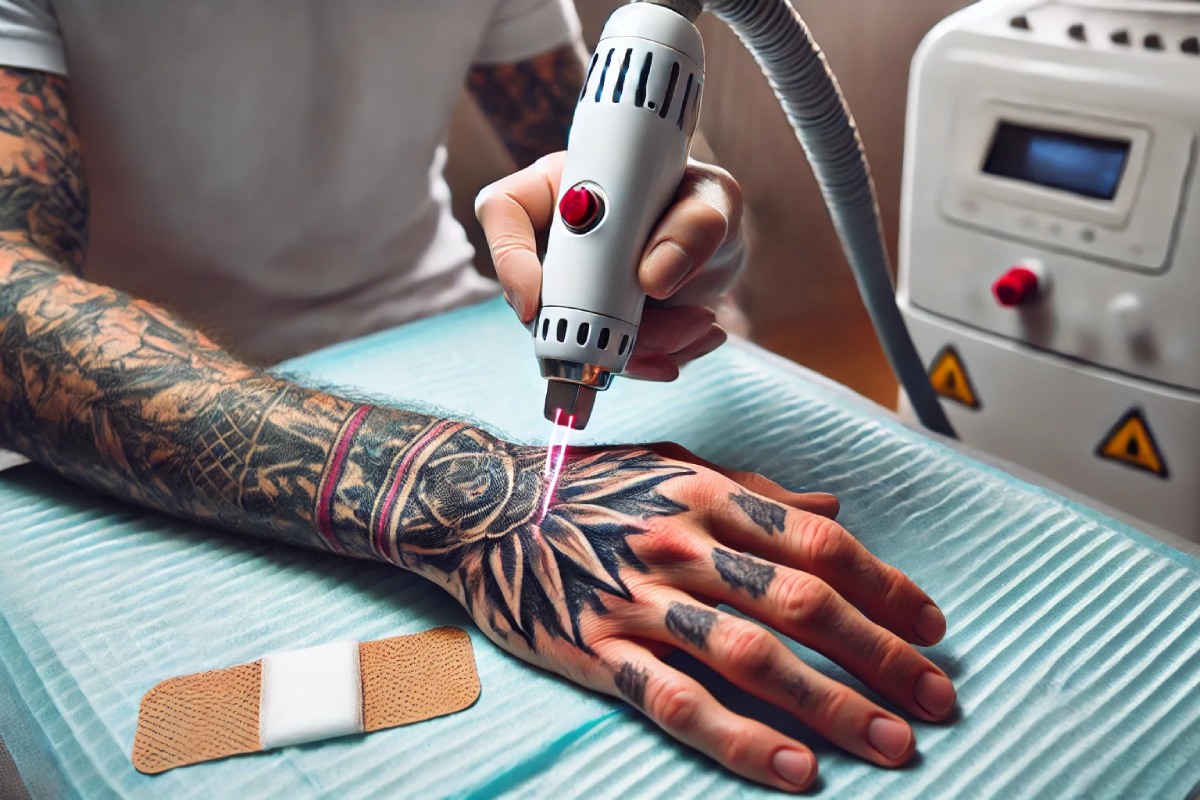
Home Laser Tattoo Removal
Have you ever looked at an old tattoo and wished you could just zap it away from the comfort of your home? You’re not alone. Many people have found themselves regretting their tattoo decisions but are hesitant about the costly and time-consuming process of professional removal. Enter home laser tattoo removal – a game-changing solution that’s both accessible and effective. But is it too good to be true? Let’s dive in and find out!
TL;DR
- Home laser tattoo removal offers a cost-effective and convenient alternative to professional treatments.
- Understanding the process, potential risks, and necessary precautions is crucial for safe and effective results.
- Choosing the right laser device and following proper aftercare are key to successful tattoo removal.
- Patience and consistency are essential – results won’t happen overnight.
- Consult a professional if you experience complications or have a large, complex tattoo.
The Rise of Home Laser Tattoo Removal
Tattoos are more popular than ever, but so are tattoo regrets. According to a survey by the Harris Poll, nearly 23% of people with tattoos regret at least one of them. This growing demand for tattoo removal has paved the way for home laser tattoo removal devices, promising professional-like results without the hefty price tag or frequent clinic visits.
Benefits of Home Laser Tattoo Removal
- Cost-Effective: Professional tattoo removal can cost thousands of dollars, especially for large or colorful tattoos. Home devices, while an investment, are generally much cheaper in the long run.
- Convenience: No need to schedule multiple appointments or travel to a clinic. You can treat your tattoo in the comfort of your own home, at your own pace.
- Privacy: Some people feel embarrassed about their tattoo removal. Doing it at home allows for more privacy and control over the process.
How Does Home Laser Tattoo Removal Work?
Home laser tattoo removal works on the same principle as professional treatments. Lasers emit pulses of light that penetrate the skin and break up the ink particles. Over time, the body’s immune system flushes these particles out, fading the tattoo.
Choosing the Right Laser Device
Not all home laser devices are created equal. When selecting a device, consider the following factors:
- Wavelength: Different wavelengths target different ink colors. Ensure the device you choose can handle the colors in your tattoo.
- Pulse Duration: Shorter pulses are generally more effective at breaking up ink particles.
- Safety Features: Look for devices with built-in safety features, such as skin sensors and adjustable settings, to minimize the risk of burns or other injuries.
Preparation and Precautions
Before starting the removal process, it’s essential to prepare your skin and take necessary precautions:
- Clean the Area: Ensure the tattooed area is clean and free of any lotions or oils. Use a mild cleanser and gently pat the area dry.
- Test Patch: Perform a test patch on a small area of your tattoo to check for any adverse reactions. Wait 24 hours to observe any skin reactions.
- Protective Gear: Wear protective goggles to shield your eyes from the laser. This step is crucial as lasers can cause severe eye damage.
- Follow Instructions: Carefully read and follow the manufacturer’s instructions for your specific device. Familiarize yourself with the settings and recommended usage.
The Removal Process
Once you’re ready, follow these steps for the removal process:
- Start Slowly: Begin with shorter sessions to allow your skin to adjust to the laser treatment. Over time, you can gradually increase the duration and intensity.
- Stay Consistent: Regular sessions, usually spaced a few weeks apart, are crucial for effective results. Consistency ensures that the ink particles are continually broken down.
- Monitor Your Progress: Keep track of your skin’s response and the fading of the tattoo. Adjust the frequency and intensity of treatments as needed. Take photos to document progress.
Aftercare and Recovery
Proper aftercare is vital to avoid complications and promote healing:
- Keep it Clean: Gently clean the treated area with mild soap and water. Avoid using harsh chemicals or abrasive scrubs. Keeping the area clean reduces the risk of infection and ensures better healing.
- Moisturize: Apply a fragrance-free moisturizer to keep the skin hydrated. Hydrated skin heals faster and minimizes the risk of scarring. Consider using aloe vera gel or a gentle, hydrating lotion to soothe the skin.
- Sun Protection: Avoid sun exposure and apply sunscreen to protect the treated area. UV rays can cause hyperpigmentation and slow down the healing process. Use a broad-spectrum sunscreen with at least SPF 30 whenever you go outside.
- Avoid Irritation: Refrain from picking at scabs or scratching the area. This can lead to scarring and infection. Let the skin heal naturally. If the area feels itchy, try applying a cold compress or an anti-itch cream to alleviate discomfort.
- Observe for Signs of Infection: Watch for signs of infection, such as increased redness, swelling, or pus. If any of these symptoms occur, contact a healthcare professional immediately for advice and treatment.
Potential Risks and Side Effects
While home laser tattoo removal is generally safe, it’s not without risks:
- Skin Irritation: Redness, swelling, and minor burns can occur, especially with improper use. It’s crucial to follow the manufacturer’s guidelines to minimize these effects.
- Hyperpigmentation: Darkening of the skin can happen if the laser is too strong or used incorrectly. This is more common in individuals with darker skin tones and can be mitigated by using lower laser settings and conducting a test patch.
- Scarring: Although rare, scarring can occur if the skin is damaged during the removal process. Avoid aggressive treatments and allow adequate healing time between sessions to reduce this risk.
- Infection: If the treated area is not kept clean or is picked at, there is a risk of infection. Always follow proper aftercare procedures to prevent this.
- Incomplete Removal: Some tattoos may not fully fade, especially those with complex colors or older, deeper inks. In such cases, professional intervention might be necessary.
If you experience severe reactions or if the tattoo doesn’t fade as expected, consult a professional. They can provide guidance and alternative treatment options to ensure your safety and desired outcomes.
Insider Tips
As someone who’s delved deep into the world of home laser tattoo removal, here are some personal insights and tips:
- Patience is Key: Tattoo removal is a gradual process. Don’t expect overnight results and avoid the temptation to rush treatments.
- Quality Matters: Investing in a high-quality device can make a significant difference in the effectiveness and safety of your treatments.
- Stay Informed: Keep up with the latest research and user reviews to ensure you’re using the best techniques and products available.
Conclusion
Home laser tattoo removal offers an exciting, cost-effective solution for those looking to part ways with their ink. By understanding the process, choosing the right device, and following proper procedures, you can achieve impressive results from the comfort of your home. Remember, patience and consistency are your best friends in this journey. If in doubt, always seek professional advice to ensure your safety and success.
Also check out: Under boob tattoo
FAQs
Can I remove any tattoo color with a home laser device?
Not all home laser devices are effective on every tattoo color. Ensure the device you choose is equipped to handle the specific colors in your tattoo.
How long does it take to see results with home laser tattoo removal?
Results vary based on the tattoo’s size, color, and depth. Most people start seeing noticeable fading after a few sessions, but complete removal can take several months.
Is home laser tattoo removal painful?
Some discomfort is expected, similar to a rubber band snapping against the skin. Pain levels vary depending on the individual’s pain tolerance and the tattoo’s location.
What are the risks of home laser tattoo removal?
Potential risks include skin irritation, hyperpigmentation, and, in rare cases, scarring. Following the device instructions and proper aftercare can minimize these risks.
Do I need to prepare my skin before using a home laser device?
Yes, ensure the area is clean and free of any lotions or oils. Performing a test patch is also recommended to check for adverse reactions.
Can I speed up the tattoo removal process?
While it’s tempting to rush, over-treating can damage your skin. Stick to the recommended treatment schedule and allow time for your skin to heal between sessions.
Are there any alternatives to home laser tattoo removal?
Yes, other options include professional laser treatments, dermabrasion, and tattoo removal creams. Each method has its pros and cons regarding effectiveness, cost, and safety.
Can home laser devices be used on all skin types?
Most devices are designed for a range of skin types, but it’s crucial to read the manufacturer’s guidelines to ensure compatibility with your skin tone.
What should I do if my skin reacts badly to the laser treatment?
Stop the treatment immediately and consult a healthcare professional if you experience severe irritation, blistering, or other adverse reactions.
Is home laser tattoo removal worth the investment?
If you’re committed to removing a tattoo and prefer the convenience and privacy of home treatments, investing in a quality device can be worthwhile. However, it requires patience and consistent effort.
Sources
- WebMD – Laser Tattoo Removal
- American Academy of Dermatology – Tattoo Removal
- Healthline – Laser Tattoo Removal















